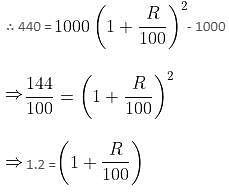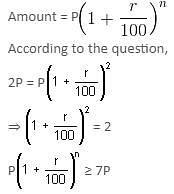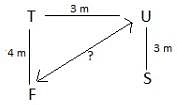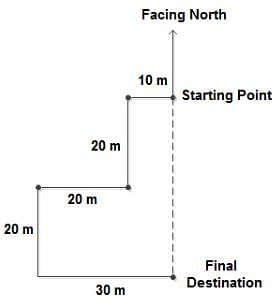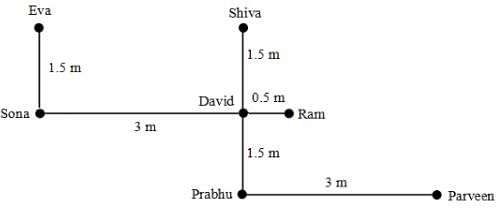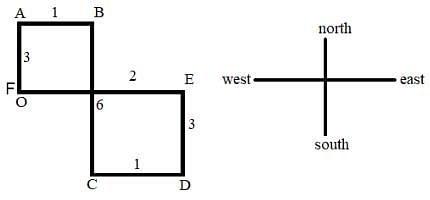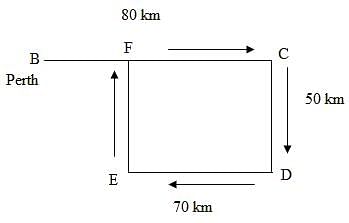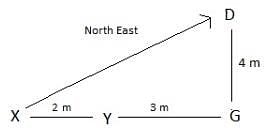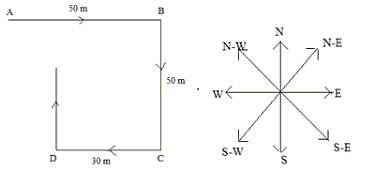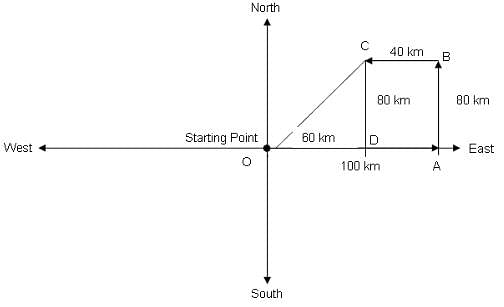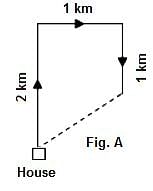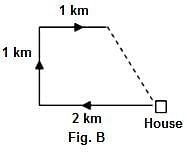CAT Practice Test: Week 9 - CAT MCQ
30 Questions MCQ Test Daily Test for CAT Preparation - CAT Practice Test: Week 9
Anjali is saving Rs. 1000 every month in a bank, where they pay 10% simple interest. How much amount will she get after 1 year?
A sum becomes 8 times its original amount in 3 years, compounded annually at a certain rate. Find the rate of interest.
If the difference between compound interest and simple interest on a certain amount at 7% per annum for two years is Rs. 7.35, then find the principal amount.
A father left a will that his capital of Rs. 18,750 should be divided between his two sons aged 12 years and 14 years, respectively, when they attain maturity at the age of 18 years. The amount received by each at 5% simple interest would be the same. Find the sum allotted to the elder son.
A borrowed Rs. 20,000 from B, at 10% p.a. compound interest. After 1 year, again A borrowed Rs. 10,000 from B at the same rate. Exactly after 1 more year, A won a lottery and wanted to repay the debt. How much would he have to pay to B?
On a sum of Rs. 1000, the compound interest for 2 years is twice the simple interest for 2 years at 11%. Find the rate at which the interest is compounded annually.
borrowed Rs. 5000 at a rate r1 simple interest. B borrowed Rs. 6000 at a rate r2 simple interest. After 5 years, both the amounts were exactly equal, what is r1/r2?
A sum of money becomes 6 times at 6.25% rate of simple interest. Find the rate at which it becomes 11 times.
Certain sum gets doubled in 2 years at compound interest. What is the minimum number of years required in which the sum should become at least 7 times?
Richa borrowed a certain amount from Priya at a rate of 10% compounded annually. She paid Rs. 11,000 at the end of the 1st year and Rs. 60,500 at the end of the second year and cleared the loan. What was the amount borrowed by Richa from Priya?
Directions: Read the following information carefully and answer the question given below.
A * B means A is to the left of B at a distance of 2 m.
A & B means A is to the west of B at a distance of 3 m.
A © B means A is to the south of B at a distance of 4 m.
A £ B means A is to the north of B at a distance of 3 m.
It is given that all the persons face north.
Q. If we have F © T & U £ S, then how far is U from F?
Anjali is facing north. She turns left and walks 10 m. She turns left again and walks 20 m. Then, she turns right and walks 20 m and then again she turns left and walks another 20 m. Finally, she turns left again and walks 30 m.
In which direction is she now from the starting point?
Sona is 1.5 m South of Eva. Ram is 3 m East of Sona and David is 0.5 m West of Ram. David is 1.5 m South of Shiva and Shiva is 3 m North of Prabhu. Praveen is 3 m East of Prabhu. In which direction is Prabhu from Eva?
Toby starts walking from a point O towards north. After walking 3 km, he reaches point A. From there, he turns to his right and after walking 1 km, reaches point B. Then, he turns to his right and after walking 6 km, reaches point C. From there, he turns to his left and after walking 1 km, reaches point D. Finally, he turns to his left and after walking 3 km, reaches point E.
If Toby turns left from point E and after walking 2 km, reaches point F, then what is the distance between O and F?
Dave drives his car from Perth to Brisbane. After 80 kilometres, he turns to his right and goes 50 kilometres. Then, he gain turns to his right and drives another 70 kilometres. He then turns to his right again and halts after driving a distance of 50 kilometres. At what distance is Dave now from Perth?
Directions: Read the following information carefully and answer the question given below.
A * B means A is to the left of B at a distance of 2 m.
A & B means A is to the west of B at a distance of 3 m.
A © B means A is to the south of B at a distance of 4 m.
A £ B means A is to the north of B at a distance of 3 m.
It is given that all the persons face north.
Q. If we have X * Y & G © D, then in which direction is D with respect to X?
Kamal is facing towards East and starts walking in that direction. After walking 50 m, he turns to his right and walks 50 m before turning to his right. He walks 30 m and again turns to his right and walks. In which direction is he walking now?
Rocky drives a car in the east direction and covers 100 km. Then he takes a turn and moves 80 km in the north direction. After that, he takes a left turn and covers 40 km, and reaches his destination. How much distance is he away from the starting position?
A school bus driver starts from the school and drives 2 km towards north. He then makes a left turn and drives 5 km. After that, he makes a left turn and drives 8 km. Next, he makes a left turn again and drives another 5 km. The driver finally makes a left turn and drives 1 km before stopping.
What distance and in which direction should the driver go to reach the school from the end point?
I start from my home and go 2 km straight. Then, I turn towards my right and go 1 km. I turn again towards my right and go 1 km. If now I am north-west from my home, then in which direction did I start in the beginning?
Directions: The passage below is followed by a question based on its content. Answer the question on the basis of what is stated or implied in the passage.
It is estimated that 90 to 95 percent of AIDS infections occur in developing countries, primarily in sub-Saharan Africa where some of the world's worst living conditions exist. According to current estimates, 70 percent of those infected with AIDS live in this region. Today, AIDS is called pandemic because it has spread to every inhabited continent in the world. Currently, the areas most affected by AIDS are Africa, India, and China.
In response to the magnitude of the AIDS crisis, countries throughout the world have developed National AIDS Programs (NAPs) adapted to the specific needs of their populations. The World Health Organization (WHO), a United Nations agency, founded a global HIV/AIDS trust fund in 1987 to help fund the NAP programs. These programs focus on the prevention of the sexual transmission of HIV and the transmission of HIV through blood and blood products, including injection drug use. The NAP programs have also supported strong international efforts to de-stigmatize AIDS and to ensure the human rights of those with HIV/AIDS. In addition, the programs attempt to reduce mother-to-child transmissions, which are a much greater issue in less affluent countries.
These national programs sometimes include working in partnerships with nongovernmental organizations (NGOs). NGOs, at the national level, provide a broad range of services, from confidential counseling and testing to support and legal services for people with AIDS. Some NGOs focus on solidarity, bringing people with AIDS together to fight the disease. The organizations work to establish AIDS self-help groups. NGOs such as Doctors Without Borders, Oxfam, and The AIDS Coalition to Unleash Power have pressed drug companies to reduce their prices to poor countries. These activists are working to get generic versions of AIDS drugs at drastically reduced prices to countries in need.
One of the few success stories in the fight against AIDS is Thailand, where the use of condoms is mandatory in brothels, which are closed down if they do not comply with government regulations. Thailand, along with Uganda, has experienced a drop in HIV infection rates and is a prime example of how prevention practices can work. Uganda was the first country to report its AIDS cases. In the 1980s this country had the world’s highest HIV infection rates, but the government responded quickly. After prevention through education and the promotion of safe-sex practices such as the use of condoms, Uganda has also experienced a decline in HIV rates.
Although some prevention efforts have succeeded, many analysts believe that the ultimate solution to the global AIDS crisis is the development of a vaccine that will prevent people from contracting AIDS in the first place. Many researchers believe that the development of a preventive vaccine is possible and absolutely necessary in order to eradicate AIDS. However, many pharmaceutical companies do not want to invest in AIDS vaccine research because of the large expense involved and the belief that profits could not be made on the vaccines. Funding for research to develop an AIDS vaccine comes from several sources, mainly the International AIDS Vaccine Initiative (IAVI), UNAIDS, the U.S. National Institutes of Health (NIH), U.S. government agencies, and a few multinational pharmaceutical companies.
In the meantime, AIDS continues to spread in the developing world. Although successes have occurred, many experts contend that much more needs to be done. They argue that the response to AIDS needs to be of greater duration, greater quality, and greater scope to reach the many areas of life which AIDS touches and affects.
Q. The most probable reason for the hesitation of pharmaceutical companies on the whole in making AIDS vaccine can be _______.
Directions: The passage below is followed by a question based on its content. Answer the question on the basis of what is stated or implied in the passage.
Competitive intelligence, or CI for short, is all about collating information about your competitors, analyzing it and using the results to formulate plans and strategies to gain the competitive edge in the marketplace. Sadly, many people confuse this with spying or other cloak and dagger activities. Nothing could be further from the truth. Competitive intelligence uses legal and ethical methods in obtaining the information - anything else is not acceptable. Data must come from the public domain but this is not limited to published articles alone, indeed much information can come from interviewing people with experience or knowledge of the target companies. What is not acceptable is bugging, overhearing conversations behind closed doors or even attempting to gain trade secrets. Coca-Cola's secret formula for example is a trade secret and no faithful CI practitioner would over attempt to discover it, but then Pepsi does not need to know what the formula is in order to compete effectively. CI practitioners abide by a strict code of ethics and these are far tighter than any legal constraints. If a method sounds in the least bit shady it's not one that they would adopt.
So where does the information come from? Information becomes available for a large number of reasons: financial information due to legal obligations and (in the case of public limited companies) duty to shareholders; product information to promote the company etc. This data emerges in from the annual reports, marketing material, applications for patents the list goes on. You must first have an understanding of why information becomes available, then think about where it might be obtained and then you can begin to work out how to obtain it. It's important to realize that information is very rarely held by only a few people. Normally the same information will be shared across a great number of sources and/or people. This is called the "information chain", and understanding it and following it is vital to the CI process. For example competitor prices are not only known by the company doing the selling but by the customers that have bought the product or service, so instead of trying to get the information from the competitor, try to get it from those that the competitor has already given it to! The information chain can be quite complex. Usually, actually obtaining the information is easy, it is thinking about where to get it from that is the difficult part. This can involve deep discussions in house and lateral thinking is a prized asset to have in this industry.
Often the person who holds the information seems quite far removed from the heart of the matter - a company security guard for example. It is such people who not only have the knowledge, but they don't know how valuable it is and therefore don't mind divulging it. Interviewing to obtain information is a skill in itself, being too keen makes an interviewee very defensive and careful about their answers. One approach is to treat the most important question as the least significant; a question that it seems you wouldn't be bothered if it weren't answered. Long pauses also yield fantastic results as people don't like silence and will fill in the gap, though this requires much self-constraint.
Not all information comes from first party (or primary) sources, Indeed, not only is it sometimes quicker and easier to obtain from published (or secondary) sources where possible but it is also essential to conduct such searches before attempting to interview for further information. Company reports hold huge amounts of financial information about a company and they are available to anyone, for a small fee. But this is raw data and the accountants who drew them up usually hide sensitive information very well. A good CI practitioner is able to dissect these accounts, sorting through all the available data to produce some valuable analysed results. The rule of thumb is to start at the back and work to the front since much of the interesting data is in the "œnotes" section.
Results don't always present themselves as a single definitive answer that is available from one or more sources (but always the same answer). Rather like a jigsaw puzzle, pieces must be gathered together, inspected to see where they each fit, until finally the bigger picture is revealed.
Competitive intelligence is at its best when the results are used proactively. For example before committing large amounts of capital to a new development or research project, companies engage CI professionals. Being told that they will be beaten to market since the competitors are much further down the line, can save companies small fortunes and divert efforts to areas where they will be first to market.
In conclusion there is not much information on a competitor that can't be obtained or calculated. Companies seem quite happy to spend many thousands of pounds "œpoaching" people from their competitors to gain information (which in itself can raise legal issues). They are then committed to employing that person in future years thereby increasing the expense year on year after the initial value of the information gained has worn off. Companies seem unaware that for a fraction of the price they could have had the same information supplied using methods that are both legal and ethical competitive intelligence.
Q. Which of the following are prerequisites for a career in CI gathering?
Directions: The passage below is followed by a question based on its content. Answer the question on the basis of what is stated or implied in the passage.
If physics leads us today to a worldview that is essentially mystical, it returns, in a way, to its beginning 2,500 years ago. It is interesting to follow the evolution of Western science along its spiral path, starting from the mystical philosophies of the early Greeks, rising and unfolding in an impressive development of intellectual thought that increasingly turned away from its mystical origins to develop a world view which is in sharp contrast to that of the Far East. In its most recent stages, Western science is finally overcoming this view and coming back to those of the early Greek and the Eastern philosophies. This time, however; it is not only based on intuition, but also on experiments of great precision and sophistication, and on a rigorous and consistent mathematical formalism.
The roots of physics, as of all Western science, are to be found in the first period of Greek philosophy in the sixth century B.C., in a culture where science, philosophy and religion were not separated. The sages of the Milesian school in Ionia were not concerned with such distinctions. Their aim was to discover the essential nature, or real constitution, of things that they called ‘physics’. The term ‘physics’ is derived from this Greek word and meant therefore, originally, the endeavor of seeing the essential nature of all things.
This, of course, is also the central aim of all mystics and the philosophy of the Milesian school and indeed has a strong mystical flavor. The Milesians were called ‘hylozoists’, or ‘those who think matter is alive’, by the later Greeks, because they saw no distinction between animate and inanimate, spirit and matter. In fact, they did not even have a word for matter, since they saw all forms of existence as manifestations of the ‘physics’, endowed with life and spirituality. Thus, Thales declared all things to be full of goods and Anaximander saw the universe as a kind of organism which was supported by ‘pneuma’, the cosmic breath, in the same way as the human body is supported by air.
The monistic and organic view of the Milesians was very close to that of ancient Indian and Chinese philosophy, and the parallels to Eastern thought are even stronger in the philosophy of Heraclitus of Ephesus.
Q. Who can be the author of the passage?
Directions: The passage below is followed by a question based on its content. Answer the question on the basis of what is stated or implied in the passage.
Technology and Culture have both influenced each other equally. Technology has been directed as an improvement in our lives, but on the other hand, Culture has been present in every invention, noticeable or not, and advancement in our evolving society. Technology is becoming focused upon more and more everyday, but culture is the determining factor that decides if there is a necessity for an improvement. There are endless views and perspectives that this situation can be viewed from, but without a doubt, Technology and Culture shape one another.
Culture has been a part of our society, and way of life, forever. It is almost impossible to come up with an idea that isn't influenced by culture. Picture our lives without cars, television, and computers. This would be an example of everyday life without technology. People could function happily in that type of atmosphere, but technology has changed our lives forever. Technology has changed our pace and perspective on education. Students would have to go to libraries and spend a lot of time researching to find out information for class assignments, but with technology students can find almost anything on there home computers and by accessing the internet. Technology has definitely become the authoritative factor in our lives, but culture has shaped technology. Technology is made and used in such a variety of ways because many people who use the technology of today come from all walks of life and have different necessities, so to compensate for that technology must adapt to all different cultures.
Q. The following is the importance of culture according to passage except that it
Directions: The passage below is followed by a question based on its content. Answer the question on the basis of what is stated or implied in the passage.
In science men change their opinions when new knowledge becomes available, but philosophy in the minds of many is assimilated rather to theology than to science. A theologian proclaims eternal truths; the creeds remain unchanged since the Council of Nicea. Where nobody knows anything, there is no point in changing your mind.
Owing to the identification of religion with virtue, together with the fact that the most religious men are not the most intelligent, a religious education gives courage to the stupid to resist the authority of educated men, as has happened, for example, where the teaching of evolution has been made illegal. So far I can remember there is not one word in the Gospels in praise of intelligence; and in this respect, ministers of religion follow gospel authority more closely than in some other.
If you think that your belief is based upon reason, you will support it by argument, rather than by persecution, and will abandon it if the argument goes against you. But if your belief is based on faith, you will realise that argument is useless, and will therefore resort to force either in the form of persecution or by stunting and distorting the minds of the young in what is called education. This last is peculiarly dastardly, since it takes advantage of the defencelessness of immature minds. Unfortunately it is practised in a greater or lesser degree in the school of every civilised country.
To modern educated people, it seems obvious that matters of fact are to be ascertained by observation, not by consulting ancient authorities. But this is an entirely modern conception, which hardly existed before the seventeenth century. Aristotle maintained that women have fewer teeth than men; although he was twice married, it never occurred to him to verify this statement by examining his wives' mouths. He said also that children would be healthier if conceived when the wind is in the north. One gathers that the two Mrs. Aristotles had to run out and look at the weathercock every evening before going to bed. He states that a man bitten by a mad dog will not go mad, but any other animal will: that the bite of the shrew mouse is dangerous to horses, especially if the mouse is pregnant; that elephants suffering from insomnia can be cured by rubbing their shoulders with salt, olive oil, and warm water; and so on and so on. Nevertheless, classical dons, who have never observed any animal except the cat and the dog, continue to praise Aristotle for his fidelity to observation.
It is not altogether true that persuasion is one thing and force is another. Many forms of persuasion – even many of which everybody approves - are really a kind of force. Consider what we do to our children. We do not say to them: 'Some people think the earth is round, and others think it flat; when you grow up, you can, if you like, examine the evidence and form your own conclusion. Instead of this we say; ' The earth is round.' By the time our children are old enough to examine the evidence, our propaganda has closed their minds, and the most persuasive arguments of the Flat Earth Society make no impression. The same applies to the moral precepts that we consider really important, such as 'don't pick your nose' or 'don't eat peas with a knife'. There may, for aught I know, be admirable reasons for eating peas with a knife, but the hypnotic effect of early persuasion has made me completely incapable of appreciating them.
Archimedes used mathematics to kill Romans, Galileo to improve the Grand Duke of Tuscany's artillery, modern physicists (grown more ambitious) to exterminate the human race. It is usually on this account that the study of mathematics is commended to the general public as worthy of State support.
Q. The central idea of the passage is that
Directions: The passage below is followed by a question based on its content. Answer the question on the basis of what is stated or implied in the passage.
It is estimated that 90 to 95 percent of AIDS infections occur in developing countries, primarily in sub-Saharan Africa where some of the world's worst living conditions exist. According to current estimates, 70 percent of those infected with AIDS live in this region. Today, AIDS is called pandemic because it has spread to every inhabited continent in the world. Currently, the areas most affected by AIDS are Africa, India, and China.
In response to the magnitude of the AIDS crisis, countries throughout the world have developed National AIDS Programs (NAPs) adapted to the specific needs of their populations. The World Health Organization (WHO), a United Nations agency, founded a global HIV/AIDS trust fund in 1987 to help fund the NAP programs. These programs focus on the prevention of the sexual transmission of HIV and the transmission of HIV through blood and blood products, including injection drug use. The NAP programs have also supported strong international efforts to de-stigmatize AIDS and to ensure the human rights of those with HIV/AIDS. In addition, the programs attempt to reduce mother-to-child transmissions, which are a much greater issue in less affluent countries.
These national programs sometimes include working in partnerships with nongovernmental organizations (NGOs). NGOs, at the national level, provide a broad range of services, from confidential counseling and testing to support and legal services for people with AIDS. Some NGOs focus on solidarity, bringing people with AIDS together to fight the disease. The organizations work to establish AIDS self-help groups. NGOs such as Doctors Without Borders, Oxfam, and The AIDS Coalition to Unleash Power have pressed drug companies to reduce their prices to poor countries. These activists are working to get generic versions of AIDS drugs at drastically reduced prices to countries in need.
One of the few success stories in the fight against AIDS is Thailand, where the use of condoms is mandatory in brothels, which are closed down if they do not comply with government regulations. Thailand, along with Uganda, has experienced a drop in HIV infection rates and is a prime example of how prevention practices can work. Uganda was the first country to report its AIDS cases. In the 1980s this country had the world’s highest HIV infection rates, but the government responded quickly. After prevention through education and the promotion of safe-sex practices such as the use of condoms, Uganda has also experienced a decline in HIV rates.
Although some prevention efforts have succeeded, many analysts believe that the ultimate solution to the global AIDS crisis is the development of a vaccine that will prevent people from contracting AIDS in the first place. Many researchers believe that the development of a preventive vaccine is possible and absolutely necessary in order to eradicate AIDS. However, many pharmaceutical companies do not want to invest in AIDS vaccine research because of the large expense involved and the belief that profits could not be made on the vaccines. Funding for research to develop an AIDS vaccine comes from several sources, mainly the International AIDS Vaccine Initiative (IAVI), UNAIDS, the U.S. National Institutes of Health (NIH), U.S. government agencies, and a few multinational pharmaceutical companies.
In the meantime, AIDS continues to spread in the developing world. Although successes have occurred, many experts contend that much more needs to be done. They argue that the response to AIDS needs to be of greater duration, greater quality, and greater scope to reach the many areas of life which AIDS touches and affects.
Q. The main purpose of this passage is to ______________.
Directions: The passage below is followed by a question based on its content. Answer the question on the basis of what is stated or implied in the passage.
The incisive observations entrenched in Parmenides' Eleatic as we know it may actually have originated in Parmenides' lecture notes, or even those of one of his students. Regardless of the origin, Kepler refers to Eleatic, written prior to 323 B.C., as "one of the most enlightening and dominant books ever produced by the human intellect".
Even though it cannot be disputed that translations of Parmenides' work were available at other places also, no proof exists demonstrating that European scholars had access to it between the fifth and ninth centuries. Parmenides was known in Turkey, and a Nestorian monk of the ninth century translated the Eleatic into Turkish from a complete Greek manuscript that is now lost. The work was translated from the Turkish in Arabic in the year 935; from this translation Altamsh of Kardaba, an Islamic philosopher, fashioned a condensed translation in the 12th century projected to "determine how much of Parmenides' book on poetry is concerned with universal rules common to all nations or to most; for most of what is found in this book consists either of rules proper to their poetry and their usage, or they are found in Arabian poetry, or they are found in other languages." Altamsh replaced Arabic examples for the Greek, possessed no notion of literature being a simulation of life, and failed to realize much of the sense of the treatise. It was, however, Altamsh's translation, translated into Latin by Herart Eledir in the thirteenth century, published in Venice in 1481 and reprinted in 1515, that was the first medium enabling Renaissance scholars to judge the content of Eleatic. This version of Eleatic circulated freely, leaving no signs that it influenced critical literature. The practice of translations into Latin (1498), into Greek by Erasmus in 1532, and into Italian by Guini in 1594 has been documented.
When the Italian Renaissance scholars were able to consider the work of Parmenides, the result was twisted not only by the number of quality of translation, but also by the nature of the Italian Renaissance itself, questions of the wished-for meaning of main words and phrases, and the enveloping influence of Horace and the ancient.
The Italians' particular ardor for form established the groundwork for the propagation of Parmenidian "rules," which evolved from faultily construed principles of the Eleatic and incorporated the add-ons of unity of place, elucidation of "nobility" to denote noticeable nobility, the Quintian five acts, and a subjective segregation of a fourth person in dialogue. In Gihhin Jinthos's work, Parmenides's prerequisite that the poet, in contrast to the historian, relate what could happen is interpreted as a requirement that the poetry represents things as they should occur. Other scholars freely amplified Parmenides' work, completing his statements by adding much of the collection of medieval guidelines and a heavy amount of Christian contemplation.
Parmenides is generally understood to have wanted that the tragic hero be "noble." Italian scholars interpreted that the tragic hero be highly famed and affluent, and the status of the actors became such a significant deliberation in the Renaissance that it was sensed to be the distinctive factor between comedy and tragedy. Other facets of drama – scheme, vista, number of players, and poetry – were caste by this construal.
Q. Which of the following statements about Italian Renaissance cannot be inferred from the passage?
Directions: Read the following passage and answer the question that follows.
The domesticated cat is an incongruity. No other animal has developed such a personal relationship with humanity, while at the same time demanding and getting such independent movement and action. The cat manages to remain a domesticated animal because of the cycle of its rearing. Living both with other same species members (its mother and littermates) and with humans (the family that has adopted it) during its formative years and kittenhood, it becomes emotionally involved and considers that it belongs to both species. It is analogical to a kid who is brought up in an alien land and becomes bilingual. The juvenile cat becomes bimental. It has twofold psyche; it is a cat physically but mentally it is both feline and human. Once it is completely grown–up, however most of its responses are feline ones and it has only one main response to its human owners. It treats them as pseudo–parents. The rationale is that they took over from the real mother at a sensitive stage of the kitten's development and went on giving it milk, solid food, and comfort as it grew up.
This is quite dissimilar from the kind of attachment that develops between human and dog. The dog sees its human owners as pseudo parents, as does the cat. On that score the process of attachment is parallel. But the dog has an extra link. Canine the social order is group–organised; feline society is not. Dogs live in group with firmly controlled grade interaction among the individuals. There are top dogs, middle dogs, and bottom dogs and under normal circumstances they move around together, keeping check on each other the whole time. So the adult domesticated dog perceives its human family both as pseudo parents and as the dominant members of the pack, hence its prominent prestige for deference and its illustrious faculty for fidelity. Even though cats also have a complex social set up, but they never stalk in group. In the wild, most of their day is spent in solitary pursuit having a walk with a human, as a result, has no charm for them. For the same reasons, "gyrating", learning to "shake hands" and "stand", are some things that do not entice them at all. Such drills are just futile for them.
Therefore the second a cat makes its owner open the door, something that humans despise a lot, it just does not bother to see the reaction of its master and move off without a second glance. As it enters the open door it jumps the barrier and is transformed. The wild cat brain takes over small human–kitten brain. The dog, however in a similar circumstance, is tempted to look back and see if his master is joining him in the fun. The cat's mind has ventured into another, absolutely feline world, where weird and wonderful biped species have no place.
Owing to this major difference between domestic cats and domestic dogs, the feline admirers have a propensity to be rather different from canine admirers. As a rule, cat–lovers have a stronger personality bias toward working alone, independent on the larger group. Artists like cats; soldiers like dogs. The much–lauded "group loyalty" phenomenon is alien to both cats and cat–lovers.
Those who have studied cat–owners and dog–owners as two discrete groups report that there is also a gender predisposition. A majority of cat–lovers are female. This prejudice is not startling if the division of labour is taken into consideration in the process of development of human society. Primitive males became specialised as group–hunters, while the female's jobs were food–gathering and childbearing. This difference added to a human male "pack attitude" that is not very prominent in the females. Coyote, the untamed ancestors of domestic dogs, also became group–hunters, so the modern dog has much more in common with the human male than with the human female.
The argument will always go on – feline self–reliance and uniqueness versus canine camaraderie and good–fellowship. But it is vital to stress that in reality all of us, have both feline and canine basics in our characters.
Q. The author suggests that a significant difference between dogs and cats is that, in contrast to dogs, cats
Directions: The passage below is followed by a question based on its content. Answer the question on the basis of what is stated or implied in the passage.
The 1980s have come to be regarded as the decade of corporate consolidation in the United States, with the number of mergers and their dollar value both setting records. Many public forums have questioned, on both social and economic grounds, the merits of this takeover frenzy. Even more controversial than the mergers themselves, however, is the reaction of the management of target firms. No longer is management content to be passive or to put up minimal resistance in the face of an unwelcome takeover attempt. Indeed, the responses of target managements have become as imaginative as the methods used by the would–be acquirers. These so–called anti-takeover tactics have received nearly universal condemnation from government regulatory bodies, the financial press, and some academic publications. Why is there so much criticism when management resists takeovers? At the most general level, such criticism is based on studies that find a negative return to shareholders when a negotiated (friendly) merger is unsuccessful. These studies examine the cumulative return from the period just prior to the first public announcement of the proposed merger through the announcement of cancellation. Results range from a total return of –9.02 per cent to + 3.68 per cent, with an average of –2.88 percent. In unsuccessful mergers, therefore, stockholders in target firms lose on average nearly 3 per cent of the shares' value.
But looking at the returns only through the termination date can be misleading. Other studies examining the period from six months prior to an offer to six months after the offer have found that the total return averages nearly +36 per cent, even though the offer was unsuccessful. Given the typical stock market reaction to unsuccessful negotiated mergers, this is a curious finding. The explanation for this seeming anomaly emerges when firms are divided into two groups: those eventually acquired by some other bidder, and those not acquired. Firms that were not acquired eventually lost the entire 36 per cent return. But firms subsequently acquired, earned an additional 20 per cent return above the initial 36 per cent, earning shareholders a total return of 56 per cent. Those earnings compare favorably to the overall average return of 30 percent earned by shareholders & of all companies successfully acquired. These results suggest that some form of resistance by management may be desirable. Playing "hard to get" may influence the initial suitor to increase the bid, or it may permit time for competing bids to be submitted. It is possible, however, to have too much of a good thing. When management actions are designed solely to eliminate a takeover by a specific bidder, then shareholders may be harmed. Nevertheless, anti-takeover tactics do not deserve the blanket condemnation they receive in the press.
Q. Which of the following, if true, would most seriously weaken the author's conclusion about the benefits of management resistance to takeovers?
Directions: The passage below is followed by a question based on its content. Answer the question on the basis of what is stated or implied in the passage.
Technology and Culture have both influenced each other equally. Technology has been directed as an improvement in our lives, but on the other hand, Culture has been present in every invention, noticeable or not, and advancement in our evolving society. Technology is becoming focused upon more and more everyday, but culture is the determining factor that decides if there is a necessity for an improvement. There are endless views and perspectives that this situation can be viewed from, but without a doubt, Technology and Culture shape one another.
Culture has been a part of our society, and way of life, forever. It is almost impossible to come up with an idea that isn't influenced by culture. Picture our lives without cars, television, and computers. This would be an example of everyday life without technology. People could function happily in that type of atmosphere, but technology has changed our lives forever. Technology has changed our pace and perspective on education. Students would have to go to libraries and spend a lot of time researching to find out information for class assignments, but with technology students can find almost anything on there home computers and by accessing the internet. Technology has definitely become the authoritative factor in our lives, but culture has shaped technology. Technology is made and used in such a variety of ways because many people who use the technology of today come from all walks of life and have different necessities, so to compensate for that technology must adapt to all different cultures.
Q. Technology as conceived in the passage is
|
152 docs|327 tests
|



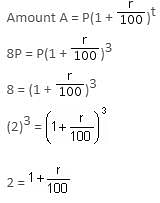


 (For 2 years)
(For 2 years)
 = Rs. 1500
= Rs. 1500 + 10,000 (1 + 10/100) = 24,200 + 11,000 = Rs. 35,200
+ 10,000 (1 + 10/100) = 24,200 + 11,000 = Rs. 35,200